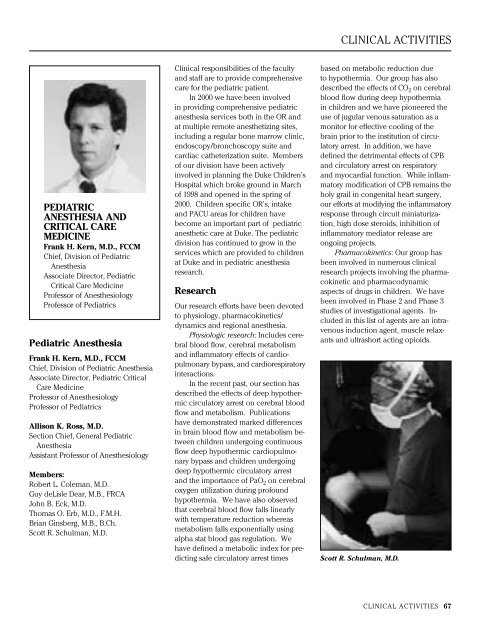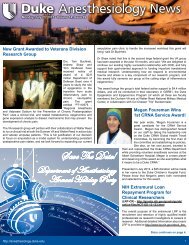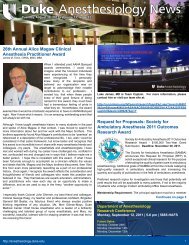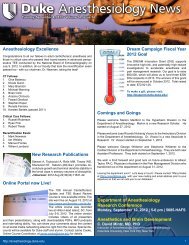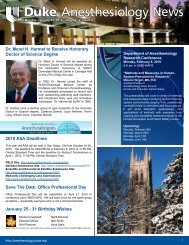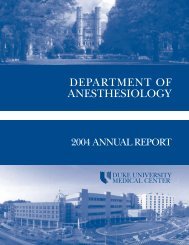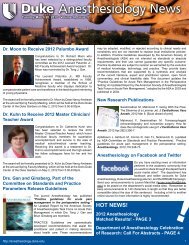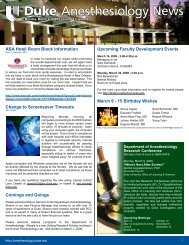DEPARTMENT OF ANESTHESIOLOGY ANNUAL REPORT
DEPARTMENT OF ANESTHESIOLOGY ANNUAL REPORT
DEPARTMENT OF ANESTHESIOLOGY ANNUAL REPORT
Create successful ePaper yourself
Turn your PDF publications into a flip-book with our unique Google optimized e-Paper software.
PEDIATRIC<br />
ANESTHESIA AND<br />
CRITICAL CARE<br />
MEDICINE<br />
Frank H. Kern, M.D., FCCM<br />
Chief, Division of Pediatric<br />
Anesthesia<br />
Associate Director, Pediatric<br />
Critical Care Medicine<br />
Professor of Anesthesiology<br />
Professor of Pediatrics<br />
Pediatric Anesthesia<br />
Frank H. Kern, M.D., FCCM<br />
Chief, Division of Pediatric Anesthesia<br />
Associate Director, Pediatric Critical<br />
Care Medicine<br />
Professor of Anesthesiology<br />
Professor of Pediatrics<br />
Allison K. Ross, M.D.<br />
Section Chief, General Pediatric<br />
Anesthesia<br />
Assistant Professor of Anesthesiology<br />
Members:<br />
Robert L. Coleman, M.D.<br />
Guy deLisle Dear, M.B., FRCA<br />
John B. Eck, M.D.<br />
Thomas O. Erb, M.D., F.M.H.<br />
Brian Ginsberg, M.B., B.Ch.<br />
Scott R. Schulman, M.D.<br />
Clinical responsibilities of the faculty<br />
and staff are to provide comprehensive<br />
care for the pediatric patient.<br />
In 2000 we have been involved<br />
in providing comprehensive pediatric<br />
anesthesia services both in the OR and<br />
at multiple remote anesthetizing sites,<br />
including a regular bone marrow clinic,<br />
endoscopy/bronchoscopy suite and<br />
cardiac catheterization suite. Members<br />
of our division have been actively<br />
involved in planning the Duke Children’s<br />
Hospital which broke ground in March<br />
of 1998 and opened in the spring of<br />
2000. Children specific OR’s, intake<br />
and PACU areas for children have<br />
become an important part of pediatric<br />
anesthetic care at Duke. The pediatric<br />
division has continued to grow in the<br />
services which are provided to children<br />
at Duke and in pediatric anesthesia<br />
research.<br />
Research<br />
Our research efforts have been devoted<br />
to physiology, pharmacokinetics/<br />
dynamics and regional anesthesia.<br />
Physiologic research: Includes cerebral<br />
blood flow, cerebral metabolism<br />
and inflammatory effects of cardiopulmonary<br />
bypass, and cardiorespiratory<br />
interactions.<br />
In the recent past, our section has<br />
described the effects of deep hypothermic<br />
circulatory arrest on cerebral blood<br />
flow and metabolism. Publications<br />
have demonstrated marked differences<br />
in brain blood flow and metabolism between<br />
children undergoing continuous<br />
flow deep hypothermic cardiopulmonary<br />
bypass and children undergoing<br />
deep hypothermic circulatory arrest<br />
and the importance of PaO 2 on cerebral<br />
oxygen utilization during profound<br />
hypothermia. We have also observed<br />
that cerebral blood flow falls linearly<br />
with temperature reduction whereas<br />
metabolism falls exponentially using<br />
alpha stat blood gas regulation. We<br />
have defined a metabolic index for predicting<br />
safe circulatory arrest times<br />
CLINICAL ACTIVITIES<br />
based on metabolic reduction due<br />
to hypothermia. Our group has also<br />
described the effects of CO 2 on cerebral<br />
blood flow during deep hypothermia<br />
in children and we have pioneered the<br />
use of jugular venous saturation as a<br />
monitor for effective cooling of the<br />
brain prior to the institution of circulatory<br />
arrest. In addition, we have<br />
defined the detrimental effects of CPB<br />
and circulatory arrest on respiratory<br />
and myocardial function. While inflammatory<br />
modification of CPB remains the<br />
holy grail in congenital heart surgery,<br />
our efforts at modifying the inflammatory<br />
response through circuit miniaturization,<br />
high dose steroids, inhibition of<br />
inflammatory mediator release are<br />
ongoing projects.<br />
Pharmacokinetics: Our group has<br />
been involved in numerous clinical<br />
research projects involving the pharmacokinetic<br />
and pharmacodynamic<br />
aspects of drugs in children. We have<br />
been involved in Phase 2 and Phase 3<br />
studies of investigational agents. Included<br />
in this list of agents are an intravenous<br />
induction agent, muscle relaxants<br />
and ultrashort acting opioids.<br />
Scott R. Schulman, M.D.<br />
CLINICAL ACTIVITIES 67


